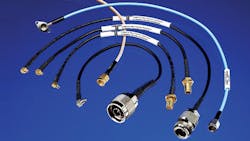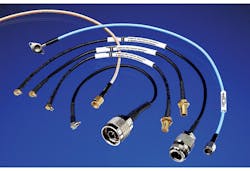This file type includes high resolution graphics and schematics when applicable.
Coaxial cable assemblies fit many applications, from connecting signals from antennas to receivers and transmitters in communications systems to transferring signals in test systems. No single cable assembly type fills all requirements, especially with the plethora of connectors and frequency bands in use in RF/microwave applications.
Although they require mechanical mating at input and output ports, the best coaxial cable assemblies are electrically invisible, with minimal degradation of signal amplitude and phase. Choosing a cable assembly, as with many high-frequency components, usually comes down to price, performance, and durability—especially for cables expected to last long lifetimes.
Cable assemblies (see figure) can be rigid or flexible, enabling them to be used both for applications that require no bending and those that call for some (or possibly many) flexures. Some cables, such as those that are part of an automatic-test-equipment (ATE) system, may need to undergo thousands of flexures, ideally with minimal changes in amplitude and phase responses versus frequency.
Some cables, such as semirigid cables, provide a limited amount of flexure for making connections in a specific configuration. Other cable assemblies, such as those based on hand-formable cables, can be flexed numerous times, bent into a required shape, and hold that shape until bent again.
Coaxial cable assemblies general consist of several components, including input and output connectors (not necessarily the same type of connector); inner and outer conductors; a dielectric insulating layer between the conductors; a conducting shield to minimize electromagnetic interference (EMI) and radio-frequency interference (RFI); and possibly a nonconducting shield around the outer conductor for environmental protection.
Stranded center conductors are used for maximum flexibility. When less flexibility is required, higher performance (less loss) can be achieved with a solid wire center conductor based on such conductive metals as bare copper or copper-clad aluminum. To minimize loss at higher frequencies, silver-plated copper wire (SPCW) or silver-plated copper-clad steel center conductors may be used.
Flexible cables are noted for their ease of installation, especially for tight connections, but they have their drawbacks. One of these is for flexible cables using a braided shield. Since it is not a smooth surface, bending can result in variations in the cable’s electrical characteristics.
Variations can also result when bending cables with stranded inner conductors employed for maximum flexibility. Such electrical variations with bending can be minimized by using a solid conductor with a coating that smooths surface imperfections, or the use of a film shield within a braided shield, at a cost of loss of flexibility.
As with any RF/microwave electronic component, coaxial cable assemblies are characterized and compared by a set of electrical, mechanical, and environmental specifications. Since many variables are involved in the construction of a coaxial cable assembly—e.g., length, connector types, diameter, power-handling capabilities, and operating temperature range—some cable suppliers provide online support in the form of cable assembly guides.
W.L. Gore & Associates offers an RF/microwave cable assembly calculator that prompts a user to enter requirements for frequency range, length, operating temperature, and even maximum altitude. Cables will then be configured with various diameters of solid or stranded conductors for applications through 67 GHz. The firm also supplies the Gore PHASEFLEX line of test cable assemblies, which operate to 110 GHz.
In addition, long-time cable supplier Micro-Coax features a handy insertion loss calculator on its website. It allows specifiers to assemble a cable assembly with desired input and output connector types and choice of coaxial cable. A user can then precisely determine the insertion loss (in dB for a given frequency) of the cable assembly, as well as the attenuation (in dB/100 ft) for a given frequency of interest.
Some cable requirements are quite simple and may even tolerate some amount of loss over the operating frequency range. Essential electrical characteristics include maximum operating frequency, impedance (typically 50 or 75 Ω), insertion loss, return loss or VSWR, shielding effectiveness (SE), power-handling capability, minimum bend radius, and operating temperature range.
A cable assembly with a small minimum bend radius, for example, may allow a flexible or hand-formable cable to complete an interconnection in a tight place. On the other hand, a cable assembly not capable of the small bend radius would not be capable of being formed into the configuration required for a tight interconnection.
Just how small a minimum bend radius for a flexible or hand-formable cable should be will depend upon a particular application. For space-related applications, NASA has recommended (per NASAâSTDâ8739.4, 7.3.21) that the optimal bend radius of a single flexible coaxial cable should be 10 times the diameter of the cable, or six times the diameter of the cable when forming and integrating the cable assembly into a system. Forming mandrels are usually advised when making an extremely tight bend radius. Some cable suppliers, such as Huber + Suhner with their 65-GHz-capable Minibend cables, can achieve a bend radius as small as 0.06 in.
Some applications, such as in test systems, may require that performance is evaluated as a function of flexure or time—for instance, changes in amplitude response over frequency with flexure and changes in phase response with frequency as a result of flexure. In some cases, the instance of flexure may occur only occasionally, such as when making connections to different test fixtures. Other applications may involve continuous flexure, such as when a device under test (DUT) is being constantly shifted during measurements (e.g., antenna radiation pattern testing).
Suppliers of flexible cables for test applications typically develop methods for evaluating their cables and cable assemblies both in static and dynamic cases. For example, Mini-Circuits supplies CBL Series test cables for use in laboratory environments with the understanding that the cables will undergo some amount of bending with normal use.
To characterize changes in performance with flexure, the company developed a test technique in which various bend radii are applied to a 3-ft. cable assembly and the changes in insertion loss, insertion phase, and VSWR are measured and normalized to the performance at a reference position for the same cable assembly. The CBL test cables are characterized for repeatable performance for as many as 20,000 flexure cycles per cable.
While no standards exist for coaxial test cable assemblies for amplitude and phase stability with flexure, amplitude stability of ±0.5 dB, and phase stability of ±2 deg. would be adequate for most test applications. Of course, both parameters will be highly dependent upon frequency, with high stability more difficult to achieve at higher frequencies.
Such cable assembly characteristics are critical in test applications because cables become part of the test system and can contribute to the measurement error of a vector network analyzer (VNA) that is being used to measure the amplitude and phase responses of other microwave components. For critical test applications, such as with VNAs, cable assemblies can be specified as phase-matched sets and with absolute or relative time delay matching for two or more cable assemblies.
Cables assemblies are available with right-angle connectors and blind-mate connectors to simplify installation, typically at frequencies to 18 GHz, while rugged, larger connectors, such as BNC and Type N connectors, may be better suited for lower-frequency applications. As a starting point, the frequency range will determine much of the construction details of a coaxial cable assembly, including the connector options for a given high-end frequency.
As frequencies increase to the millimeter-wave range, available connectors shrink and the number of connector and cable options diminishes. Connector dimensions, such as those for 3.5- and 2.4-mm connectors, shrink as a function of wavelength and shrink with increasing frequencies.
In addition to operating temperature range—like the extreme range of -55 to +125°C—environmental factors that contribute to the selection of a cable assembly include humidity, shock and vibration, and altitude (for use in airborne systems). Ruggedized cables with armored jackets are also available for use in harsh conditions, as are space-qualified cables. The latter typically undergo thermal vacuum testing to qualify the cable assemblies for high-reliability applications, such as in space systems.
Looking for parts? Go to SourceESB.
This file type includes high resolution graphics and schematics when applicable.
About the Author
Jack Browne
Technical Contributor
Jack Browne, Technical Contributor, has worked in technical publishing for over 30 years. He managed the content and production of three technical journals while at the American Institute of Physics, including Medical Physics and the Journal of Vacuum Science & Technology. He has been a Publisher and Editor for Penton Media, started the firm’s Wireless Symposium & Exhibition trade show in 1993, and currently serves as Technical Contributor for that company's Microwaves & RF magazine. Browne, who holds a BS in Mathematics from City College of New York and BA degrees in English and Philosophy from Fordham University, is a member of the IEEE.


